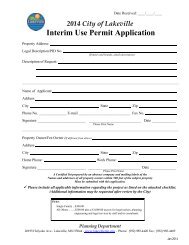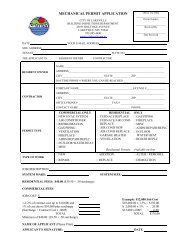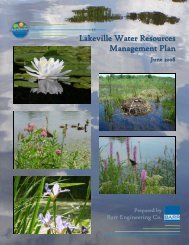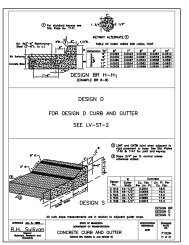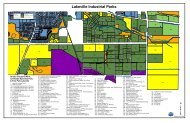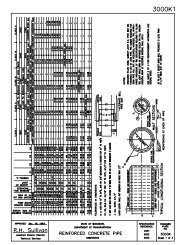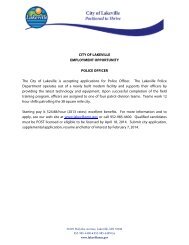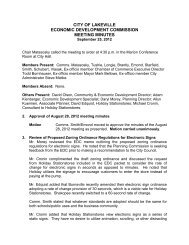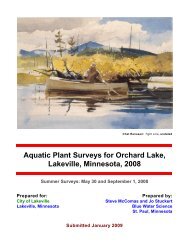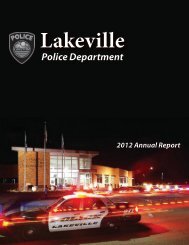2006 Parks, Trails and Open Space Plan - City of Lakeville
2006 Parks, Trails and Open Space Plan - City of Lakeville
2006 Parks, Trails and Open Space Plan - City of Lakeville
You also want an ePaper? Increase the reach of your titles
YUMPU automatically turns print PDFs into web optimized ePapers that Google loves.
<strong>Lakeville</strong>’s <strong>Parks</strong>, <strong>Trails</strong> <strong>and</strong> <strong>Open</strong> <strong>Space</strong> <strong>Plan</strong> is an important tool in maintaining the<br />
community’s quality <strong>of</strong> life. On-going l<strong>and</strong> development is diminishing available open<br />
space within the urbanized area. Park acquisition within the current MUSA area should<br />
be completed while open space still exists to provide uniform park service. Acquisition<br />
<strong>of</strong> park l<strong>and</strong>s outside <strong>of</strong> the MUSA area should occur in anticipation <strong>of</strong> development <strong>and</strong><br />
at moderate l<strong>and</strong> costs. <strong>Lakeville</strong> must plan <strong>and</strong> prepare for the next twenty-five years<br />
today to preserve its future open space options. The community survey revealed<br />
support for acquisition <strong>of</strong> additional park l<strong>and</strong>s <strong>and</strong> greenway/conservancy areas as a<br />
means to control growth <strong>and</strong> preserve current open space within the <strong>City</strong>.<br />
• <strong>Lakeville</strong> is a distinct community with unique physical <strong>and</strong> geographic<br />
characteristics. The <strong>Parks</strong>, <strong>Trails</strong> <strong>and</strong> <strong>Open</strong> <strong>Space</strong> <strong>Plan</strong> must respond with specific<br />
measures that preserve, promote <strong>and</strong> enhance its natural characteristics. The<br />
proactive implementation <strong>of</strong> greenways planning is intended to focus on the<br />
preservation <strong>and</strong> protection <strong>of</strong> the <strong>City</strong>’s valuable environmental sensitive areas. The<br />
greenway preservation was strongly promoted in the <strong>Lakeville</strong> Growth Management<br />
Strategies, the 1998 Comprehensive <strong>Plan</strong> <strong>and</strong> the 2000 <strong>Parks</strong>, <strong>Trails</strong> <strong>and</strong> <strong>Open</strong><br />
<strong>Space</strong> <strong>Plan</strong>. Implementation <strong>of</strong> the greenway strategies is just now bearing out with<br />
development <strong>of</strong> extensive trails within the Central Area <strong>of</strong> the <strong>City</strong> accompanying<br />
new commercial <strong>and</strong> residential development <strong>and</strong> extension <strong>of</strong> the South Creek<br />
greenway from the new South High School to Downtown <strong>Lakeville</strong>.<br />
• The MUSA line location will have an effect on this plan’s content. <strong>Lakeville</strong>’s MUSA<br />
boundaries will change based upon the staged growth areas through the year 2020.<br />
Staging <strong>of</strong> the designated Urban Reserve <strong>and</strong> Permanent Rural areas <strong>of</strong> the <strong>City</strong> is<br />
anticipated to be addressed as part <strong>of</strong> the <strong>City</strong>’s 2008 Comprehensive <strong>Plan</strong> update.<br />
Residential density, community population, <strong>and</strong> the development program for<br />
recreational facilities are all impacted by the MUSA staged expansion.<br />
• <strong>Lakeville</strong>’s future population projections suggest that continued residential<br />
development can be expected through 2030. This growth will place increased<br />
pressure on existing recreation facilities <strong>and</strong> potentially consume the undeveloped<br />
natural resource base. Future park planning must be integral to new subdivisions to<br />
provide safe <strong>and</strong> convenient access to public recreational facilities within new growth<br />
areas.<br />
• <strong>Lakeville</strong>’s growth consists predominantly <strong>of</strong> young families, children, adolescents<br />
<strong>and</strong> middle aged adults. The 2000 Census revealed that 31 percent <strong>of</strong> <strong>Lakeville</strong>’s<br />
population was children ages 14 <strong>and</strong> younger <strong>and</strong> 38 percent <strong>of</strong> the population was<br />
adults ages 25 to 44. Both <strong>of</strong> these population groups experienced growth from<br />
1990 to 2000. It is forecast that the in-migration <strong>of</strong> young families will remain the<br />
dominant growth trend within the <strong>City</strong> through 2010 <strong>and</strong> beyond. However, it<br />
continues to be critical to recognize the maturation <strong>of</strong> existing <strong>Lakeville</strong> households<br />
<strong>and</strong> the changing recreational needs <strong>of</strong> a maturing population.<br />
<strong>City</strong> <strong>of</strong> <strong>Lakeville</strong>, Minnesota<br />
Chapter Four<br />
<strong>2006</strong> Comprehensive <strong>Parks</strong>, <strong>Trails</strong>, & <strong>Open</strong> <strong>Space</strong> <strong>Plan</strong> Page 72



